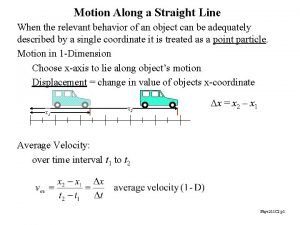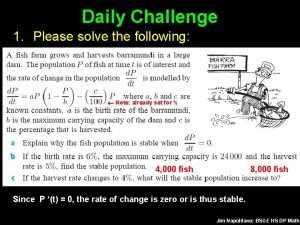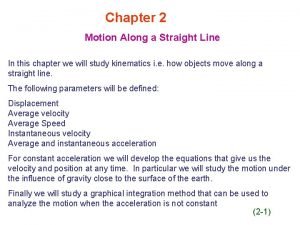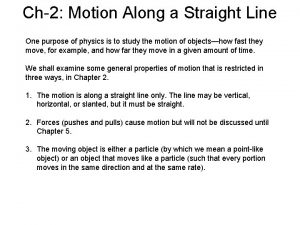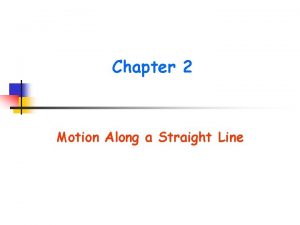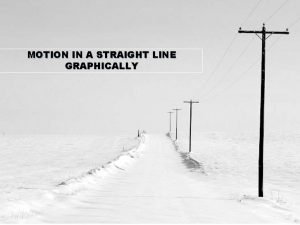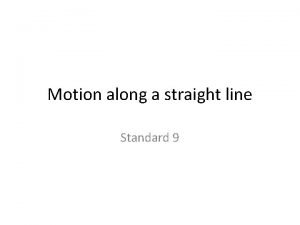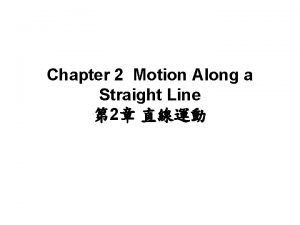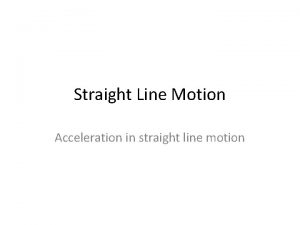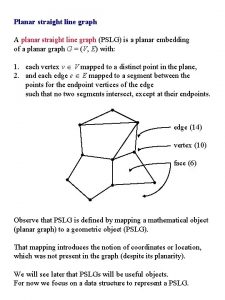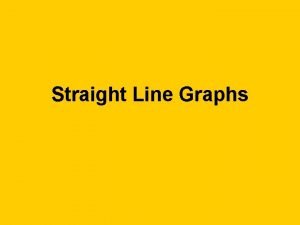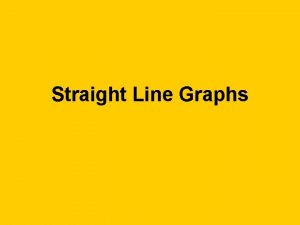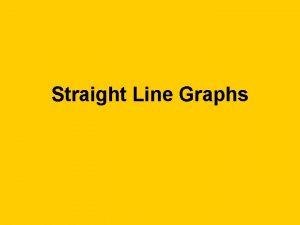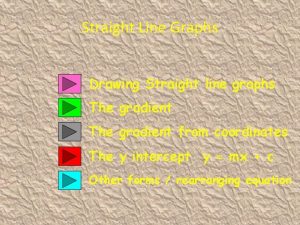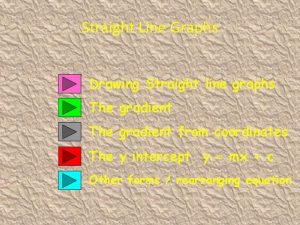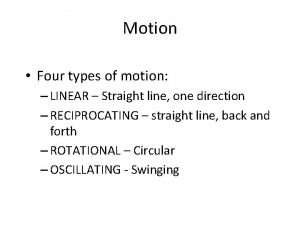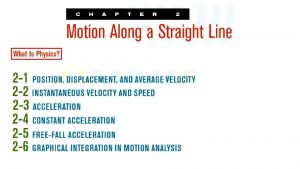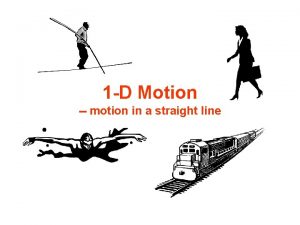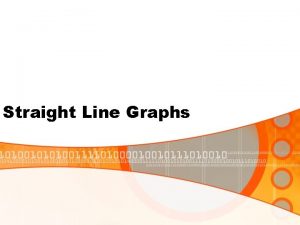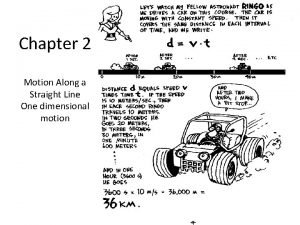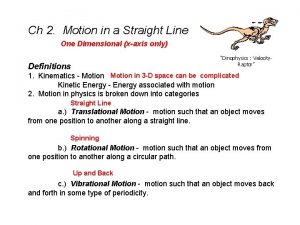Ch 2 Motion in a Straight Line One





















- Slides: 21

Ch 2. Motion in a Straight Line One Dimensional (x-axis only) “Dinophysics : Velocity. Raptor” Definitions 1. Kinematics - Motion in 3 -D space can be complicated Kinetic Energy - Energy associated with motion 2. Motion in physics is broken down into categories Straight Line a. ) Translational Motion - motion such that an object moves from one position to another along a straight line. Spinning b. ) Rotational Motion - motion such that an object moves from one position to another along a circular path. Up and Back c. ) Vibrational Motion - motion such that an object moves back and forth in some type of periodicity.

Example: Diatomic Molecule Moving Through Space. f n tio a l s n ra T t e N i X - Dir Note: In this chapter all objects are going to be considered POINT PARTICLES – No Spatial Extent – No Rotations – No Vibrations

Speed 1. Speed - How fast an object is moving regardless of what direction it is moving. ≡ Equality by Definition Example 1 Traveling from your parking space at Conestoga to New York City and back to Conestoga. Find your average speed for the round trip. One way travel = 130 mi. Total Distance Traveled = 260 mi. Total time elapsed = 5. 2 hrs. or (5 hrs 12 min) Speed Calculations are EASY Always distance / time Round Trip Average Speed

Displacement - Change in position (straight line distance with direction) Must specify a coordinate system. Example: Cartesian coordinate system y(m) xi = xinitial= Initial Position xf = xfinal = Final Position up back ∆ “Delta” xi= 2 m xf= 6 m x 1 x 2 x(m) Delta x is the displacement or change in the x position Mathematical Notation for Direction

Average Velocity Avg. Velocity - How fast an object is moving and in what direction it is moving. ≡ Equality by Definition

Notation for Displacement & Velocity = x “hat”, and has a value of one. The sole purpose of is to indicate the direction Example Problem: A particle initially at position x = 5 m at time t= 2 s moves to position x = -2 m and arrives at time t = 4 s. a. ) Find the displacement of the particle. b. ) Find the average speed and velocity of the particle.

Example Problem 1 revisited Example 1. Traveling from your parking space at Conestoga to New York City and back to Conestoga. The straight line distance from Conestoga to Y is 97 mi. One way travel = 130 mi. Total Distance Traveled = 260 mi. Travel time Con. to NY = 2. 6 hrs. Travel time NY to Con. = 2. 6 hrs. a. ) What was the avg speed from Conestoga to NY? b. ) What was the avg velocity from Conestoga to NY? c. ) What was the avg speed for the round trip? d. ) What was the avg velocity for the round trip? Speed in PATH DEPENDENT. Velocity is PATH INDEPENDENT. It only depends on the initial and final positions.

A number (with units) that Scalar vs. Vector Quantities Scalar - Quantity that has magnitude only. describes how big or small - Mass - Speed - Length - Energy Vector - A quantity that has both magnitude and direction. - Position - Acceleration - Velocity - Forces Example: Length vs. Position Scalar Vector = x “hat”, and is called a unit vector in the x-direction. It has a magnitude of one (hence the name unit) and is used solely to specify direction.

Concepts Check – The Negatives Q. Can speed be negative? A. NO! – The least speed an object can have is zero – it is at rest Q. Can velocity be negative? A. YES! Negative velocity means an object is moving backwards. E. g. An object moving is moving backwards with a speed of 10 m/s Q. Can distance be negative? A. NO! – The least distance an object can move is zero – it is at rest Q. Can displacement be negative? A. YES! Negative displacement means an object moved backwards. E. g. An object with a displacement ∆x of moved backwards 10 m.

Both of these movements describe an object moving in one dimension along the x-axis! NOT up and to the right! Position vs. Time Graph x Y 1 Y 2 Time (s) Position (m) 0 0 0 1 1 5 2 4 10 3 9 15 4 16 20 5 25 25 Movement 1 Movement 2 Dx=rise Dt=run Movement 1 1 s 2 s ● ● 0 3 s ● 4 s ● 5 m 10 m 15 m 20 m 25 m ● 1 s ● 2 s ● 3 s ● 4 s ● 5 s Movement 2

Position vs. Time Graph for a Complete Trip Slope of the secan t line is vavg x y Time (s) Position (m) 0 0 10 200 25 150 45 -100 60 0 Find the average velocity as the object moves from: a. ) A to B b. ) B to C c. ) C to D d. ) A to E

Velocity vs. Time (Constant Velocity) run Dx rise Slope Area ∆t = base v = height

Velocity vs. Time Graph for a Complete Trip +X Area = 200 m Area = -50 m −X Area =250 m

Instantaneous Velocity (Average velocity) recall: ∆t = 1. 5 sec A. Consider the function x(t): ∆t = 0. 2 sec B. ● ● ● The instantaneous velocity at the time t = ti is the limiting value we get by letting the upper value of the tf approach ti. Mathematically this is expressed as: The velocity function is the time derivative of the position function Differentiation (Calculus) .

Acceleration When the instantaneous velocity of a particle is changing with time, the particle is accelerating (Average Acceleration) Units: Example: If a particle is moving with a velocity in the x-direction given by a. ) What is the average acceleration over the time interval

Example: Instantaneous Acceleration Stopped a. ) Find aavg. over the time interval 5 t 8 b. ) What is the acceleration at time t = 6 s ? Slope of tangent – pick 2 points on the tangent line. Answer will we smaller than the answer to part a, c. ) What is the acceleration when the velocity of the particle is zero? Objects with zero velocity can be accelerating!

Positive and Negative Accelerations v(m/s) C Moving Forward Stopped 0 Moving Backward B D E A t (s) F A→B: Slowing Down, Moving Backward, Pt. B=Stop B→C: Speeding Up, Moving Forward C→D: Constant Speed, Moving Forward D→E: Slowing Down, Moving Forward, Pt. E=Stop E→F: Speeding Up, Moving Backward

Special Case: Constant Acceleration We make the assumption that the acceleration does not change. Near the surface of the earth, (where most of us spend most of our time) the acceleration due to gravity is approximately constant ag = 9. 8 m/s 2 a(m/s 2) a 0 ti = 0 tf = t t (s) Area! 1. Slope! v(m/s) vf vi 0 ti = 0 tf = t t (s) Area! Slope! x(m) xf xi ti = 0 2. tf = t t (s)

Solving for the 3 rd constant acceleration equation Solve equation 1 for t and substitute t into equation 2 to get the following equation. 3.

FREE-FALL ACCELERATION (9. 8 m/s 2 = 32 ft/s 2) Consider a ball is thrown straight up. It is in “Free Fall” the moment it leaves you hand. Plot y(t) vs. t for the example above. y(t) t/2 top Moving up tf Plot v(t) vs. t Stopped 0 Moving down t/2 tf Ground Level

FINAL NOTES ON CH 2. Remember , when going between the following graphs x(t) Slope v(t) Area Under Curve a(t) Problem Solving with the constant acceleration equations 1. Write down all three equations in the margin 2. a = 9. 8 m/s 2 for free fall problems 3. Analyze the problem in terms of initial and final sections.
 Motion in straight line formula
Motion in straight line formula Motion along a straight line definition
Motion along a straight line definition Straight line motion revisited homework
Straight line motion revisited homework Motion along a straight line
Motion along a straight line It is the motion along a straight line
It is the motion along a straight line Motion along a straight line examples
Motion along a straight line examples Straight line motion equations
Straight line motion equations Graph of uniform motion
Graph of uniform motion Motion along a line
Motion along a line Chapter 2 motion along a straight line
Chapter 2 motion along a straight line A plain scale of 1 cm=5m and show on it 37m
A plain scale of 1 cm=5m and show on it 37m One's self i sing meaning
One's self i sing meaning One empire one god one emperor
One empire one god one emperor Little dog run
Little dog run One king one law one faith
One king one law one faith One empire one god one emperor
One empire one god one emperor One ford plan
One ford plan See one do one teach one
See one do one teach one See one, do one, teach one
See one, do one, teach one Structure of twelfth night
Structure of twelfth night Studiendekanat uni bonn
Studiendekanat uni bonn Asean tourism strategic plan
Asean tourism strategic plan

